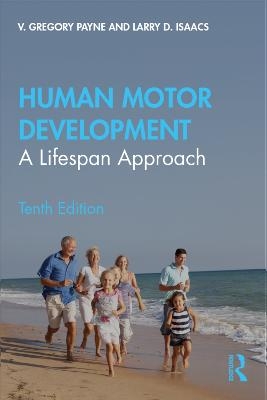
Human Motor Development
Routledge (Verlag)
978-0-367-34737-6 (ISBN)
- Titel ist leider vergriffen;
keine Neuauflage - Artikel merken
Human Motor Development: A Lifespan Approach, 10th Edition, offers an overview to the study of changes in human movement across the lifespan. The book uses a holistic approach and emphasizes the importance of intellectual, social, and physical development and their impact on human motor development at all ages.
The tenth edition has been completely revised and updated to reflect the most recent research and technology in human motor development. Organized into five parts, the book examines key topics in motor development including the relationship between cognitive and social development and motor development, factors affecting development, changes across the lifespan, and assessment in motor development.
Highly illustrated and written for student accessibility, Human Motor Development: A Lifespan Approach is essential reading for students of motor control and development, kinesiology, human performance, and students interested in physical therapy, physical education, and exercise science. The book also provides access to a fully updated companion website, which includes laboratory exercises, an instructors’ manual, a test bank, and lecture slides.
V. Gregory Payne is a Professor Emeritus in the Department of Kinesiology at San Jose State University, USA. He formerly served as the Associate Dean for Research in the College of Applied Sciences and Arts and as Chair of the Department of Kinesiology. Payne is a specialist in human motor development with interests ranging from aging and physical activity to children’s sports and fitness. He received a BS degree from Western Illinois University and later received that institution’s Distinguished Alumni Award. He earned an MA from the University of Iowa and his PED from Indiana University. Payne worked for the Venezuelan Ministry of Education as a Peace Corps Volunteer in Venezuela following college. As a human motor development researcher and educator, Payne has produced over 170 publications, including numerous refereed articles and 19 editions of five books, and has made nearly 300 presentations throughout the world. He is an elected Fellow of the National Academy of Kinesiology and was a member of the task force that developed the NASPE National Physical Education Standards. The many honors and awards Payne has received include being selected International Professor of the Year at SJSU, receiving the Distinguished Service Award from the California Governor’s Council on Physical Fitness and Sports and the prestigious Research Quarterly for Exercise and Sport Research Writing Award for research involving children’s physical activity and cardiovascular endurance. He has held offices in several organizations including President of NASPE and Chair of the Motor Development Academy. He is an elected Fellow of the National Academy of Kinesiology and the Research Consortium of AAHPERD (SHAPE America), has chaired two editorial boards, and has reviewed for many journals. Larry D. Isaacs is Professor Emeritus and former Director of the Exercise Physiology Program, Department of Biological Sciences, College of Science and Mathematics at Wright State University, USA. Isaacs received both his BS and MS degrees from Virginia Commonwealth University, where he specialized in human motor development and also developed a strong interest in both human physiology and exercise physiology. Following four years of public school teaching, Isaacs attended the University of Maryland and received his doctorate in 1979. He continues to serve as a reviewer for many scholarly journals. In addition, he has published numerous scholarly articles and has authored, coauthored, and contributed to 21 textbooks. He is certified with the American College of Sports Medicine (Certified Exercise Physiologist) and was awarded Research Fellow status by AAHPERD/SHAPE. In addition, he has received the Wright State University Presidential Recognition award for research. Isaacs continues to work part-time as a clinical exercise physiologist at Hilton Head Hospital, Hilton Head Island, South Carolina, where he works with both cardiac and pulmonary patients.
Part I
1. Introduction to Motor Development
2. Cognitive and Motor Development
3. Social and Motor Development
Part II
4. Prenatal Development Factors
5. Effects of Early Stimulation and Deprivation
Part III
6. Growth and Maturation
7. Physiological Changes: Health-Related Physical Fitness
8. Movement and the Changing Senses
Part IV
9. Infant Reflexes and Stereotypies
10. Voluntary Movements of Infancy
11. Fine Motor Development
12. Fundamental Locomotion Skills of Childhood
13. Fundamental Object-Control Skills of Childhood
14. Youth Sports
15. Movement in Adulthood
Part V
16. Assessment
| Erscheinungsdatum | 19.03.2020 |
|---|---|
| Zusatzinfo | 98 Tables, black and white; 11 Line drawings, color; 64 Line drawings, black and white; 107 Halftones, color; 32 Halftones, black and white; 118 Illustrations, color; 96 Illustrations, black and white |
| Verlagsort | London |
| Sprache | englisch |
| Maße | 178 x 254 mm |
| Gewicht | 1156 g |
| Themenwelt | Sachbuch/Ratgeber ► Sport |
| Medizin / Pharmazie ► Medizinische Fachgebiete ► Sportmedizin | |
| Studium ► 1. Studienabschnitt (Vorklinik) ► Physiologie | |
| ISBN-10 | 0-367-34737-7 / 0367347377 |
| ISBN-13 | 978-0-367-34737-6 / 9780367347376 |
| Zustand | Neuware |
| Haben Sie eine Frage zum Produkt? |
aus dem Bereich


